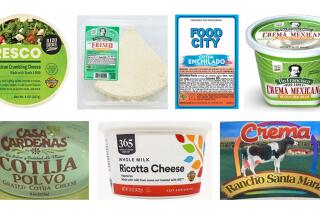Santa Ana Firm Says EPA Data Is Outdated
Cal-Compack Foods Inc. in Santa Ana has long been known for the chili powder it produces.
But Thursday, the firm gained public attention for a different reason: The small manufacturer of food ingredients was listed among 205 industrial plants that release unregulated amounts of dangerous chemicals, some that are suspected carcinogens, into the atmosphere.
The list, based on a preliminary report compiled by the Environmental Protection Agency, was released by Rep. Henry A. Waxman (D-Los Angeles) to underscore the need for tougher air standards.
Serious Health Threat
Although none of the companies, including Cal-Compack, are violating federal law, the report suggests that those living and working near the plants are potentially being exposed to a serious health threat.
The EPA identified the problem pollutant at the Santa Ana plant as ethylene oxide, a chemical for sterilizing equipment used to process food ingredients, such as the chili powder manufactured by the firm, a subsidiary of Beatrice-Hunt Wesson.
In 1987, the EPA said, residents near the facility in the 4900 block of West 1st Street faced a 1-in-1,000 chance of developing cancer because of ethylene oxide that escaped or was released into the air. Health officials also said the highly explosive chemical may cause pregnancy problems and birth defects in newborns.
A Cal-Compack spokesman said, however, that the threat posed by the chemical emissions has been greatly reduced since the 1987 figures were supplied to the EPA.
Frank Quevedo, director of corporate relations for Beatrice-Hunt Wesson, said Cal-Compack stopped using ethylene oxide for most of 1988 as company experts studied the health issues raised by its use.
In the end, he said, company officials bought an incinerator to destroy ethylene oxide once the chemical had been used at the plant, which employs about 100 people. Scrubbers were also added to the incinerator to further reduce emissions.
The company began using ethylene dioxide again earlier this year.
“We are in compliance and have been in compliance with every regulatory agency around,” Quevedo said. “We have a system in place that effectively deals with the issue.”
According to Quevedo, Cal-Compack uses the ethylene dioxide as a fumigant, to rid the plant of insects or unwanted substances that may foul food ingredients. The chemical is widely used in the medical industry because of its thoroughness and reliability to clean and sterilize equipment and tools.
‘Rattle Some Cages’
Quevedo said his company has no quarrel with Waxman releasing the EPA statistics if his aim is to “rattle some cages and gain some political mileage” for gaining increased government regulation on such emissions. But he said the EPA report unfairly paints his company and others as dangerous polluters, because the study relies on 2-year-old data.
“The data isn’t current and does not take into consideration what we have done to improve the situation,” he said. “It’s like mixing apples and oranges.”
But Quevedo declined to disclose the plant’s current emission levels of ethylene oxide, figures that must be reported to the federal government, except to say that they have been reduced “significantly” since 1987.
More to Read
Inside the business of entertainment
The Wide Shot brings you news, analysis and insights on everything from streaming wars to production — and what it all means for the future.
You may occasionally receive promotional content from the Los Angeles Times.










